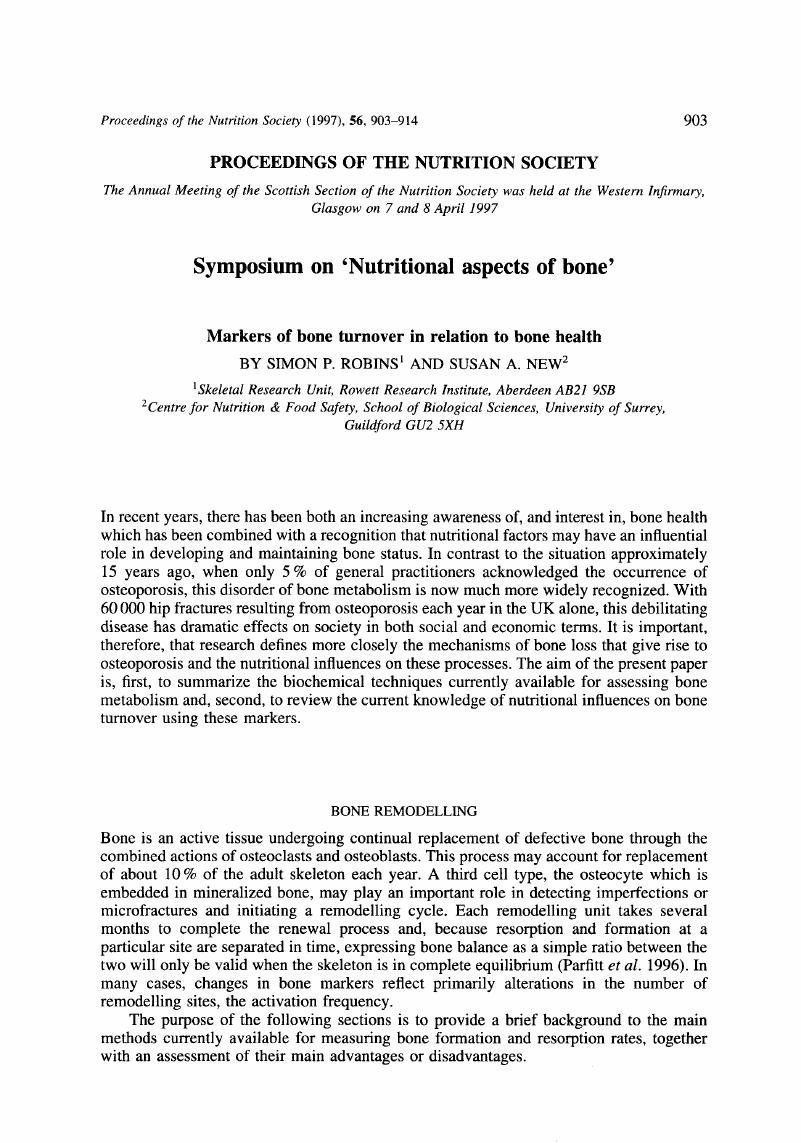Crossref Citations
This article has been cited by the following publications. This list is generated based on data provided by Crossref.
Cashman, Kevin D.
and
Flynn, Albert
1999.
Optimal nutrition: calcium, magnesium and phosphorus.
Proceedings of the Nutrition Society,
Vol. 58,
Issue. 2,
p.
477.
Vidal-Quintanar, Reyna Luz
Mendívil, Reyna Luz
Peña, Mireya
and
Fernandez, Maria Luz
1999.
Lime-treated maize husks lower plasma LDL-cholesterol levels in normal and hypercholesterolaemic adult men from northern Mexico.
British Journal of Nutrition,
Vol. 81,
Issue. 4,
p.
281.
Branca, Francesco
1999.
Physical activity, diet and skeletal health.
Public Health Nutrition,
Vol. 2,
Issue. 3a,
p.
391.
Creedon, Annette
Flynn, Albert
and
Cashman, Kevin
1999.
The effect of moderately and severely restricted dietary magnesium intakes on bone composition and bone metabolism in the rat.
British Journal of Nutrition,
Vol. 82,
Issue. 1,
p.
63.
Swaminathan, R
1999.
NUTRITIONAL FACTORS IN OSTEOPOROSIS.
International Journal of Clinical Practice,
Vol. 53,
Issue. 7,
p.
540.
Baker, Aimi
Turley, Eithne
Bonham, Maxine P.
O'Connor, Jacqueline M.
Strain, J. J.
Flynn, Albert
and
Cashman, Kevin D.
1999.
No effect of copper supplementation on biochemical markers of bone metabolism in healthy adults.
British Journal of Nutrition,
Vol. 82,
Issue. 4,
p.
283.
Cohen, A.J
and
Roe, F.J.C
2000.
Review of risk factors for osteoporosis with particular reference to a possible aetiological role of dietary salt.
Food and Chemical Toxicology,
Vol. 38,
Issue. 2-3,
p.
237.
Buttriss, Judy
Bundy, Rafe
and
Hughes, Joyce
2000.
An update on vitamin K: contribution of MAFF‐funded research.
Nutrition Bulletin,
Vol. 25,
Issue. 2,
p.
125.
Creedon, Annette
and
Cashman, Kevin D.
2001.
The effect of calcium intake on bone composition and bone resorption in the young growing rat.
British Journal of Nutrition,
Vol. 86,
Issue. 4,
p.
453.
Cashman, KD
Baker, A
Ginty, F
Flynn, A
Strain, JJ
Bonham, MP
O'Connor, JM
Bügel, S
and
Sandström, B
2001.
No effect of copper supplementation on biochemical markers of bone metabolism in healthy young adult females despite apparently improved copper status.
European Journal of Clinical Nutrition,
Vol. 55,
Issue. 7,
p.
525.
Schulting, Rick J
and
Richards, Michael P
2001.
Dating Women and Becoming Farmers: New Palaeodietary and AMS Dating Evidence from the Breton Mesolithic Cemeteries of Téviec and Hoëdic.
Journal of Anthropological Archaeology,
Vol. 20,
Issue. 3,
p.
314.
O’Connor, J. M.
Bonham, M. P.
Turley, E.
Kehoe, C.
Coulter, J. S.
Faughnan, M. S.
McKeown, A.
McKelvey-Martin, V. J.
Rock, E.
Rayssiguier, Y.
Mazur, A.
Flynn, A.
Cashman, K.
Baker, A.
and
Strain, J. J.
2002.
Trace Elements in Man and Animals 10.
p.
943.
Schulting, Rick J.
and
Richards, Michael P.
2002.
The wet, the wild and the domesticated: The Mesolithic–Neolithic transition on the west coast of Scotland.
European Journal of Archaeology,
Vol. 5,
Issue. 2,
p.
147.
Tucker, Katherine L
Chen, Honglei
Hannan, Marian T
Cupples, L Adrienne
Wilson, Peter WF
Felson, David
and
Kiel, Douglas P
2002.
Bone mineral density and dietary patterns in older adults: the Framingham Osteoporosis Study,,.
The American Journal of Clinical Nutrition,
Vol. 76,
Issue. 1,
p.
245.
Audí, Laura
Vargas, Deisi M
Gussinyé, Miquel
Yeste, Diego
Martí, Gertrudis
and
Carrascosa, Antonio
2002.
Clinical and Biochemical Determinants of Bone Metabolism and Bone Mass in Adolescent Female Patients with Anorexia Nervosa.
Pediatric Research,
Vol. 51,
Issue. 4,
p.
497.
IWAMA, Yuko
KAMIYA, Mitsuru
TANAKA, Masahito
and
SHIOYA, Shigeru
2004.
The change of dry matter intake, milk yield and bone turnover in primiparous cows compared to multiparous cows during early lactation.
Animal Science Journal,
Vol. 75,
Issue. 3,
p.
213.
Cimaz, Rolando
and
Falcini, Fernanda
2005.
Textbook of Pediatric Rheumatology.
p.
716.
Babraj, John A
Smith, Kenneth
Cuthbertson, Daniel JR
Rickhuss, Peter
Dorling, James S
and
Rennie, Michael J
2005.
Human Bone Collagen Synthesis Is a Rapid, Nutritionally Modulated Process.
Journal of Bone and Mineral Research,
Vol. 20,
Issue. 6,
p.
930.
Cimaz, R.
and
Guez, S.
2005.
Diagnostic et traitement de l'ostéoporose juvénile.
Archives de Pédiatrie,
Vol. 12,
Issue. 5,
p.
585.
Jugdaohsingh, R.
O'Connell, M. A.
Sripanyakorn, S.
and
Powell, J. J.
2006.
Moderate alcohol consumption and increased bone mineral density: potential ethanol and non-ethanol mechanisms.
Proceedings of the Nutrition Society,
Vol. 65,
Issue. 3,
p.
291.



